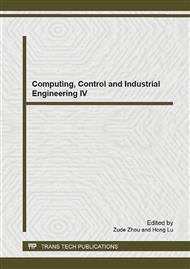p.349
p.354
p.358
p.363
p.366
p.370
p.374
p.378
p.384
Research on Peak-to-Average Power Ratio for OFDM System
Abstract:
OFDM is a special multi-carrier modulation, its basic idea is to make high-speed transmission of data flow through the serial-parallel conversion and make it to be the low-speed transmission of data flow in a number of narrow-band orthogonal sub-channels. However, a major drawback of OFDM signals is their high Peak-to-Average Power Ratio (PAPR), which makes the inter modulation distortion occur due to the nonlinearity of the high power amplifier. The distortion severely deteriorates the performance of the OFDM systems. According the problems mentioned above, this dissertation focuses on the reducing the PAPR algorithms design for OFDM systems, such as SLM and PTS. In summary, this paper has completed the OFDM system simulation with Matlab and analyses the result.
Info:
Periodical:
Pages:
366-369
Citation:
Online since:
October 2013
Authors:
Price:
Сopyright:
© 2013 Trans Tech Publications Ltd. All Rights Reserved
Share:
Citation:


